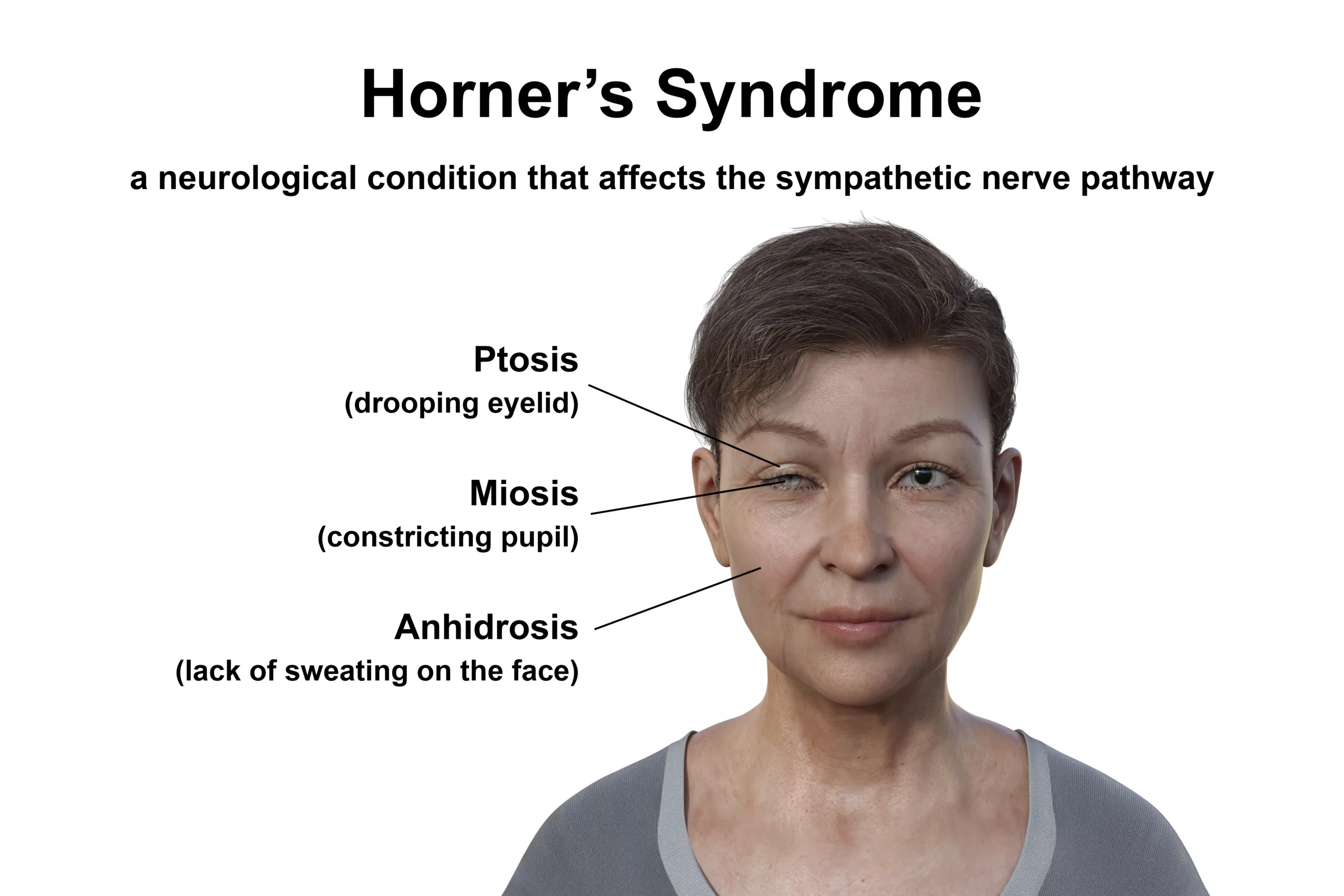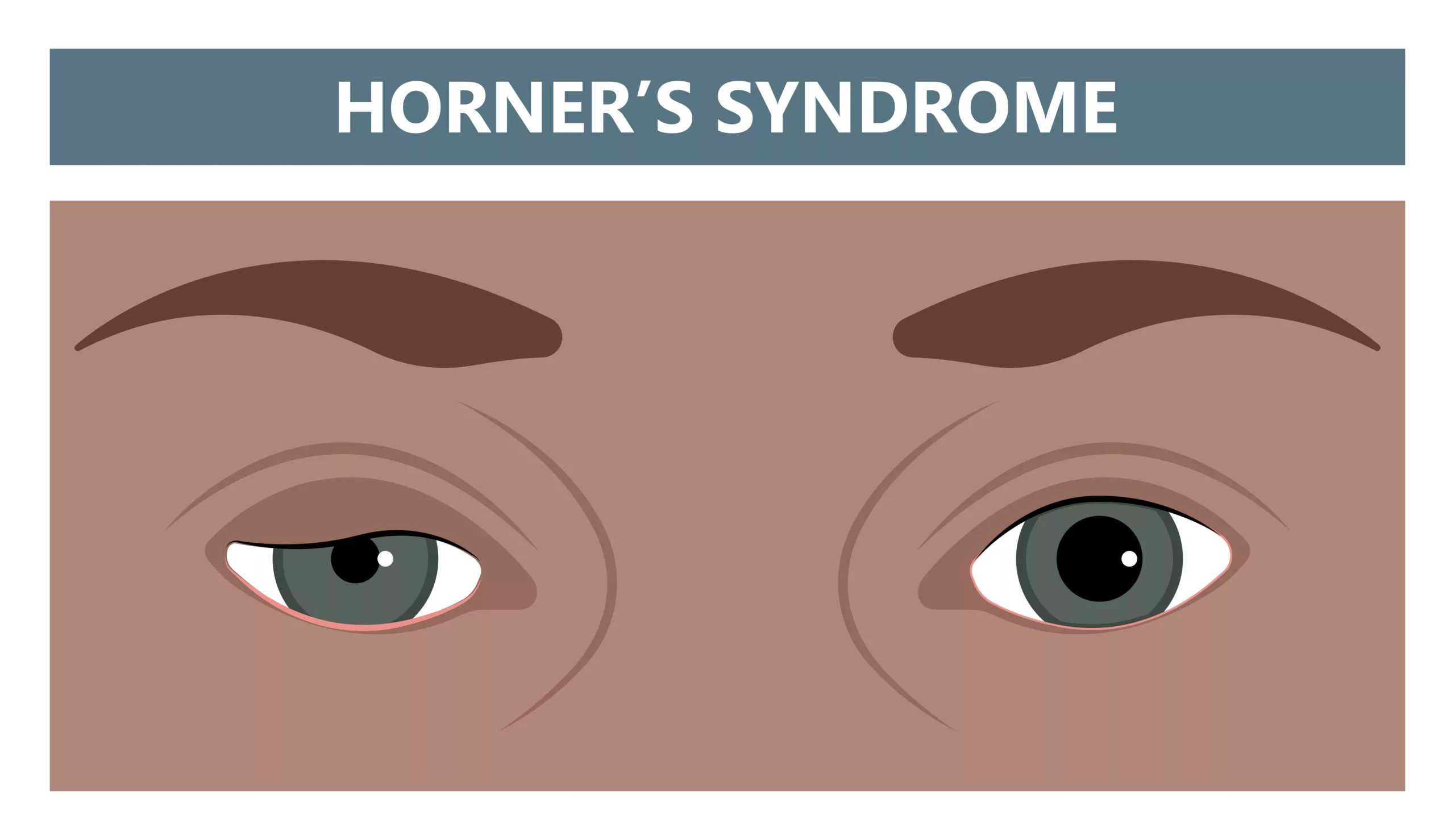Adie’s pupil is a rare neurological disorder that affects the pupil of the eye. In most cases, the affected pupil becomes larger than normal (dilated) and shows a slow or poor reaction to light. However, it usually responds better when focusing on near objects (accommodation). Although the condition is commonly named after British neurologist William John Adie,1Bruyn GW, Gooddy W. Adie’s syndrome. In: Neurological Eponyms, Koehler PJ, Bruyn GW, Pearce JMS (Eds), Oxford University Press, New York 2000. p.181. it was actually described almost at the same time in 1931 by several doctors, including Adie, Morgan, Symonds, and Holmes.2Morgan OG, Symonds CP. Internal Ophthalmoplegia with Absent Tendon-jerks. Proc R Soc Med. 1931 May;24(7):867-9. PMID: 19988108; PMCID: PMC2182862. This is why, in some cases, you might hear it referred to as Holmes-Adie syndrome when tendon reflex abnormalities are also present.
What is Adie’s Pupil?
Adie’s pupil, sometimes referred to as Adie’s tonic pupil or tonic pupil, is caused by parasympathetic denervation of the eye muscles that control pupil constriction. Normally, the pupil acts like a shutter, constricting in bright light and dilating in the dark. But in Adie’s disease, the pupil remains abnormally dilated even in bright sunlight and reacts sluggishly to changes in light. When the patient focuses on a near object, the pupil may constrict better, but then it re-dilates very slowly once they look away — a hallmark feature known as tonic redilation.
The condition is relatively rare, affecting about 2 out of every 1000 people. It is most commonly seen in young adults, with the average age of diagnosis around 32 years, and it occurs more frequently in women than men.3Sarao MS, Elnahry AG, Sharma S. Adie Syndrome. [Updated 2023 Jul 4]. In: StatPearls [Internet]. Treasure Island (FL): StatPearls Publishing; 2024 Jan-. Available from: https://www.ncbi.nlm.nih.gov/books/NBK531471/ While Adie’s pupil can appear without a known cause (idiopathic), it may sometimes follow trauma, eye surgery, ischemia, or infections that damage the ciliary ganglion or postganglionic nerve fibers.
In rare cases, Adie’s pupil may be part of Ross syndrome, a condition that combines tonic pupil, absent reflexes, and areas of reduced sweating (focal dyshidrosis).
Pathogenesis of Tonic Pupil
Adie’s pupil occurs due to damage to the ciliary ganglion, a group of nerve cells responsible for controlling the muscles in the eye. The parasympathetic nerves, which control the pupil and ciliary muscle (responsible for focusing the lens), travel through the third cranial nerve and synapse in the ciliary ganglion.
When the ciliary ganglion is damaged, the nerve fibers attempt to repair themselves, but this process doesn’t always work as expected. Some of the nerve fibers that should have gone to the ciliary muscle for focusing the lens may instead travel to the iris, causing an abnormal reaction. This is known as aberrant regeneration.
As a result, the pupillary light reflex becomes impaired, leading to a larger pupil that reacts poorly to light. However, it responds more readily to focusing on nearby objects, leading to a phenomenon called light-near dissociation. This condition causes anisocoria (unequal pupil size), where one pupil may appear larger than the other, especially in bright light.4McDougal, D. H., & Gamlin, P. D. (2015). Autonomic control of the eye. Comprehensive Physiology, 5(1), 439–473. https://doi.org/10.1002/cphy.c140014
Causes of Tonic Pupil
Adie’s pupil is mainly associated with infectious diseases. There is evidence of autoimmune processes playing a role. Tumors and localized trauma have also been linked to the occurrence of Adie’s pupil.
When poor tendon reflexes and the Adie’s pupil are present, the disease is called Holmes-Adie Syndrome. Infections that affect the eye and surrounding tissue that may cause Adie’s pupils are:
- Syphilis
- Lyme Disease
- Cat Scratch Fever
- Shingles (Herpes Zoster)
- Herpes simplex
- Mumps
- Measles
Symptoms of Adie’s Pupil
Typically, only one eye is affected at first, although in some cases, both eyes may eventually be involved. The affected pupil fails to constrict properly in response to light, leading to a sluggish or absent pupillary light reflex. This results in blurred vision, difficulty focusing on near objects, increased sensitivity to light (photophobia), and problems with reading or other close work. The affected pupil is often noticeably larger than the other, causing anisocoria (unequal pupil size).
How is Adie’s Pupil diagnosed?
Initially, an ophthalmologist performs a detailed eye examination. The goal is to rule out structural causes such as orbital trauma, tumors, inflammation, or other diseases that can affect the pupil. Making a definitive diagnosis can be challenging and requires significant clinical experience and understanding to avoid misdiagnosis.
The doctor may perform several examinations to differentiate Adie’s pupil from other conditions:
- The patient’s pupils are checked in natural light. In Adie’s syndrome, the affected pupil typically remains dilated even in bright environments, failing to constrict normally.
- A dilute 0.125% pilocarpine test may be used to confirm the diagnosis. When pilocarpine drops are applied to both eyes, the affected pupil shows constriction due to denervation supersensitivity, whereas the normal pupil remains largely unchanged.5Yoo, Y. J., Hwang, J. M., & Yang, H. K. (2021). Dilute pilocarpine test for diagnosis of Adie’s tonic pupil. Scientific reports, 11(1), 10089. https://doi.org/10.1038/s41598-021-89148-w
- On exposure to direct bright light using a flashlight, the affected pupil remains sluggish and shows little to no reaction, while the normal pupil constricts briskly and re-dilates once the light is removed.
- Additionally, light-near dissociation may be noted, where the near reaction (focusing on a close object) is better preserved than the light response.
Differential Diagnosis
Adie’s tonic pupil should be distinguished from the following conditions to prevent mistreatment:
Oculomotor Nerve Palsy:
In addition to dilated pupils, ptosis and restricted eye movements are present.
Drug Overdose:
Usually, Atropine overdose presents with similar symptoms. Excessive intake may cause hallucinations, delirium, tachycardia, and agitation.
Argyll- Robertson Pupil:
Patients exhibit bilateral miosis (small pupils) and absent light reflexes. However, accommodation and convergence responses are preserved, a phenomenon known as “light-near dissociation.” In Adie’s pupil, the pupil is slow to react to light. On the contrary, in the case of Argyll Robertson Pupils, the pupils do not react to light at all.
Congenital Mydriasis:
It is a congenital disease that affects both pupils. Pilocarpine is ineffective in these patients.
Adie’s Pupil Vs. Horner Syndrome
Adie’s pupil is sometimes confused with Horner’s syndrome because both conditions cause anisocoria (unequal pupil size), but in opposite ways.
In Adie’s pupil, one or both pupils are abnormally dilated (mydriasis) and poorly responsive to light. In Horner’s syndrome, the affected pupil is constricted (miosis).
.

Causes:
The causes of Horner’s syndrome include nerve injury, birth trauma, stroke, and carotid dissection. On the other hand, causes of Adie’s pupil include inflammation, Guillain-Barre Syndrome, Human papillomavirus, and syphilis.
Difference of Pathophysiology:
As far as pathophysiology is concerned, there is damage to the sympathetic innervation of the eye in Horner’s syndrome. On the contrary, in the case of Adie’s pupil, there is damage to the postganglionic fibers of the ciliary ganglion due to inflammation.
Some characteristic features of Horner’s syndrome6Sarao MS, Elnahry AG, Sharma S. Adie Syndrome. [Updated 2023 Jul 4]. In: StatPearls [Internet]. Treasure Island (FL): StatPearls Publishing; 2024 Jan-. Available from: https://www.ncbi.nlm.nih.gov/books/NBK531471/ are:
• Ptosis: Drooping eyelids
• Miosis: Constricting pupil
• Anhidrosis: loss of sweating on the face

Treatment of Adie’s Pupil
Adie’s pupil is often idiopathic, but when an underlying cause such as infection, trauma, or tumor is identified, the treatment should focus on addressing that condition. Management of associated autonomic neuropathies may also be necessary.
For symptom control, patients are often prescribed reading glasses to improve near vision, as accommodation can be impaired. Low-dose pilocarpine drops may also be used to constrict the dilated pupil and reduce sensitivity to light. In addition, patients are advised to wear sunglasses or photochromic lenses to alleviate photophobia.
Although many patients experience some improvement in pupillary function over time, full recovery is uncommon. Nevertheless, Adie’s pupil is not a life-threatening condition, and most individuals can lead healthy, normal lives with appropriate management.
Prognosis of Treatment
The prognosis for Adie’s tonic pupil varies among individuals. Some patients experience partial recovery within a few months, while in others, recovery may take several years. However, complete restoration of normal pupil function is uncommon, and some degree of pupillary abnormality may persist permanently.
The condition is not life-threatening and typically does not follow a progressive course. It does not lead to significant disabilities. In cases where Adie’s syndrome is associated with loss of deep tendon reflexes, these reflexes may slowly diminish over time. Rarely, Adie’s pupil has been associated with angle-closure glaucoma, although this complication is exceedingly uncommon.7Leibovitch, I., Kurtz, S., & Almog, Y. (2002). Adie’s tonic pupil-induced angle-closure glaucoma. Ophthalmologica. Journal international d’ophtalmologie. International journal of ophthalmology. Zeitschrift fur Augenheilkunde, 216(1), 71–72. https://doi.org/10.1159/000048302
Most patients benefit from reassurance, as the condition is benign and manageable. Over time, the initially dilated pupil may become smaller than the unaffected eye — a phenomenon sometimes referred to as a “little old Adie.”
Complications of Adie’s Pupil
Minor complications of Adie’s pupil include difficulty with reading and photophobia, both of which are manageable with appropriate interventions. Rare but more significant concerns involve segmental palsy of the iris sphincter, cholinergic supersensitivity of the denervated muscle, and, when part of Holmes-Adie syndrome, cardiovascular abnormalities such as orthostatic hypotension.
Low-Angle Closure Glaucoma:
In rare instances, Adie’s tonic pupil has been associated with angle-closure glaucoma, leading to symptoms such as blurred vision and ocular pain. Treatment focuses on reducing intraocular pressure, and laser peripheral iridotomy may be performed to prevent pupillary block.8Leibovitch, I., Kurtz, S., & Almog, Y. (2002). Adie’s tonic pupil-induced angle-closure glaucoma. Ophthalmologica. Journal international d’ophtalmologie. International journal of ophthalmology. Zeitschrift fur Augenheilkunde, 216(1), 71–72. https://doi.org/10.1159/000048302
Amblyopia – Potential Complication of Adies Pupil:
Adie’s pupil has also been reported as a potential cause of amblyopia in children due to accommodative paresis leading to hypermetropia. Management includes correcting the refractive error with glasses and employing occlusion therapy when needed9Majumdar S, Tripathy K. Hyperopia. [Updated 2023 Aug 25]. In: StatPearls [Internet]. Treasure Island (FL): StatPearls Publishing; 2024 Jan-. Available from: https://www.ncbi.nlm.nih.gov/books/NBK560716/
What is Holmes-Adies Syndrome?
Holmes-Adie syndrome is a neurological condition characterized by the presence of Adie’s tonic pupil along with the loss of deep tendon reflexes, most commonly the Achilles tendon reflex. It may develop as a result of viral infections, diseases like syphilis, or may occur idiopathically without an identifiable cause.
Is Adies Pupil Dangerous?
No, Adies pupil is not a life threatening disease. It does not progress or become worse. However, the loss of deep tendon reflexes can be permanent if a person is suffering from Holmes-Adies Syndrome.
Conclusion
Adie’s pupil is a neurological disorder. A denervated parasympathetic supply alters normal eye reflex. The eye responds to light immediately by constriction of the pupil and remains dilated to high exposure to sunlight.
The patient might face photophobia and difficulty in reading as the optimum level of light reflection is not maintained. The condition is manageable and rarely progresses to some severe condition. The condition does not threaten life in any way. Its treatment holds an overall good prognosis.
Refrences
- 1Bruyn GW, Gooddy W. Adie’s syndrome. In: Neurological Eponyms, Koehler PJ, Bruyn GW, Pearce JMS (Eds), Oxford University Press, New York 2000. p.181.
- 2Morgan OG, Symonds CP. Internal Ophthalmoplegia with Absent Tendon-jerks. Proc R Soc Med. 1931 May;24(7):867-9. PMID: 19988108; PMCID: PMC2182862.
- 3Sarao MS, Elnahry AG, Sharma S. Adie Syndrome. [Updated 2023 Jul 4]. In: StatPearls [Internet]. Treasure Island (FL): StatPearls Publishing; 2024 Jan-. Available from: https://www.ncbi.nlm.nih.gov/books/NBK531471/
- 4McDougal, D. H., & Gamlin, P. D. (2015). Autonomic control of the eye. Comprehensive Physiology, 5(1), 439–473. https://doi.org/10.1002/cphy.c140014
- 5Yoo, Y. J., Hwang, J. M., & Yang, H. K. (2021). Dilute pilocarpine test for diagnosis of Adie’s tonic pupil. Scientific reports, 11(1), 10089. https://doi.org/10.1038/s41598-021-89148-w
- 6Sarao MS, Elnahry AG, Sharma S. Adie Syndrome. [Updated 2023 Jul 4]. In: StatPearls [Internet]. Treasure Island (FL): StatPearls Publishing; 2024 Jan-. Available from: https://www.ncbi.nlm.nih.gov/books/NBK531471/
- 7Leibovitch, I., Kurtz, S., & Almog, Y. (2002). Adie’s tonic pupil-induced angle-closure glaucoma. Ophthalmologica. Journal international d’ophtalmologie. International journal of ophthalmology. Zeitschrift fur Augenheilkunde, 216(1), 71–72. https://doi.org/10.1159/000048302
- 8Leibovitch, I., Kurtz, S., & Almog, Y. (2002). Adie’s tonic pupil-induced angle-closure glaucoma. Ophthalmologica. Journal international d’ophtalmologie. International journal of ophthalmology. Zeitschrift fur Augenheilkunde, 216(1), 71–72. https://doi.org/10.1159/000048302
- 9Majumdar S, Tripathy K. Hyperopia. [Updated 2023 Aug 25]. In: StatPearls [Internet]. Treasure Island (FL): StatPearls Publishing; 2024 Jan-. Available from: https://www.ncbi.nlm.nih.gov/books/NBK560716/





